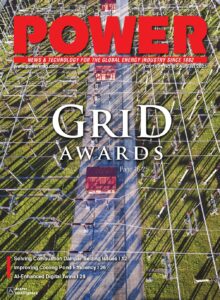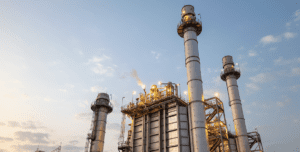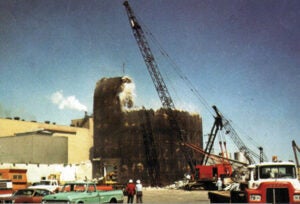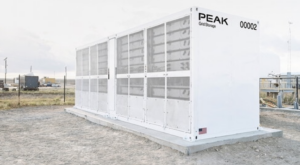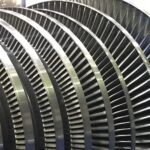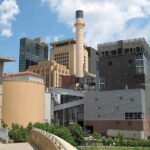As electricity demand soars during summer heat waves, many power plants find themselves constrained by their ability to cool water efficiently for reuse. Innovative floating cooling technology is enabling operators to overcome these thermal limitations and maintain full power output when it matters most.
Cooling ponds and sprayer ponds are found at power plants across the energy generation landscape. They are used to provide cold water for steam plant operation, and to provide a heat sink to recirculate and cool hot water used from the facility. In coal plants and combined cycle plants, water generally exits at about 170F. That water then must be cooled enough inside the pond for it to be reusable. This works well for part of the year, but during the summer months, the water temperature often doesn’t drop enough for complete reuse. As a result, some facilities are forced to curtail power output due to not having enough cold water for operation.
There are remedy options such as cooling towers and chiller plants. However, not everyone has the space or resources to deploy them. Instead, some operators are resolving this issue with mobile cooling units that sit on the pond, suck up the warm water, and cool it steadily at low cost and high efficiency. These floating cooling towers raise heat rejection capacity for cooling layers, sprayers, ponds (Figure 1), and cooling return canals.
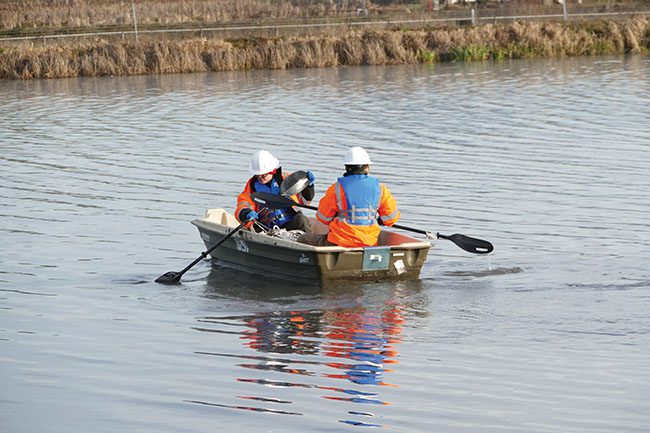 |
|
1. Cooling ponds, sprayer ponds, cooling layers, and cooling return canals are found beside power plants across the Americas. They are used as part of the steam generation process. Courtesy: RWI Enhanced Evaporation |
Water Usage in Power Plants
Power plants consume a lot of water. Whether it’s a nuclear, coal, biomass, fuel oil, natural gas combined cycle, or a solar plant in some cases, water is flashed to steam as part of the power generation process. The steam is then condensed into hot water and returned to a cooling loop.
In the past, heat was often discarded via once-through cooling. In recent years, the subject of water conservation has gained more prominence, particularly in hot, dry states and in areas suffering long-term droughts. As a result, practices such as once-through cooling have either been eliminated or greatly reduced.
Instead, cooling ponds and sprayer ponds are often used to dissipate heat in the water exiting a power plant. Their purpose is to make water temperature low enough to allow its reuse in cooling. This is a relatively efficient way of dissipating heat that does not produce harmful emissions or require the use of chemicals to maintain water quality. The depth and overall size of the cooling pond must be sufficient to accommodate the waste heat generated by the power plant. They are typically man-made and serve as an alternative to cooling towers.
The majority of U.S. power plants use cooling ponds, according to the U.S. Energy Information Administration. U.S. Environmental Protection Agency studies show that cooling ponds have a lower overall electrical cost than cooling towers while providing the same benefits.
Industry estimates suggest that cooling ponds (Figure 2) typically require 20–30 acre-feet of water volume per megawatt of generating capacity, with actual requirements varying based on climate conditions and plant efficiency. This translates to roughly 2–3 acres of surface area per megawatt when accounting for typical pond depths of 8–12 feet. For example, a 1.3 GW power plant would need approximately 26,000–39,000 acre-feet of cooling pond capacity (equivalent to 8.5–12.7 billion gallons of water storage) to maintain adequate heat rejection. The actual surface area would cover about 4–6 square miles, providing sufficient thermal mass and residence time to cool heated discharge water from about 104F back to acceptable intake temperatures of 68–77F before recirculation.
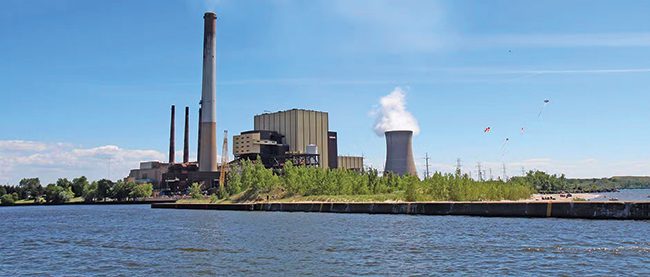 |
|
2. Cooling ponds and sprayer ponds suffer from a variety of challenges, such as algae, aeration, and pollution issues. During warm weather, the pond may not be able to stay at temperatures that are low enough to reach the threshold needed for water reuse within the plant. Courtesy: RWI Enhanced Evaporation |
Cooling Pond Problems
While cooling ponds are popular, efficient, and relatively low cost, they can run into challenges. Major plants may have trouble finding enough land for a large enough pond. They can also run into algae, aeration, and pollution issues—particulate matter from the plant can find its way into the pond and settle on the bottom.
But the biggest problem for power generation operations is warm weather. During the summer, ambient air raises the temperature of the pond. As hot water is pumped in, the pond can no longer lower temperatures enough to reach the threshold needed for use within the plant. Each facility has a temperature specification for the water inlet. When it isn’t met, the operator is forced to dial power production back to reduce the amount of heat being returned to the pond.
“During the summer, many facilities can’t operate at 100% at the very time that demand is at its highest point,” said Robert Ballantyne Jr., atomic and molecular spectroscopist at RWI Enhanced Evaporation.
RWI Enhanced Evaporation has developed a solution known as HydraCool (Figure 3). It acts, in effect, as a floating cooling tower that sits on top of a cooling pond to lower the water temperature. It deploys a fan design to reduce parasitic loading and increase overall efficiency. In addition, strict droplet size control supports maximum cooling and minimizes the need for makeup water. Made of marine-grade stainless steel, aluminum, and composite to be long-lasting and corrosion resistant, it provides a pumping rate of 250 to 400 gallons per minute. They are available in sizes from 6–30 tons capacity. One such floating unit is usually enough to provide auxiliary cooling of 2,700 tons per hour to the pond. They can be deployed as temporary or permanent installations.
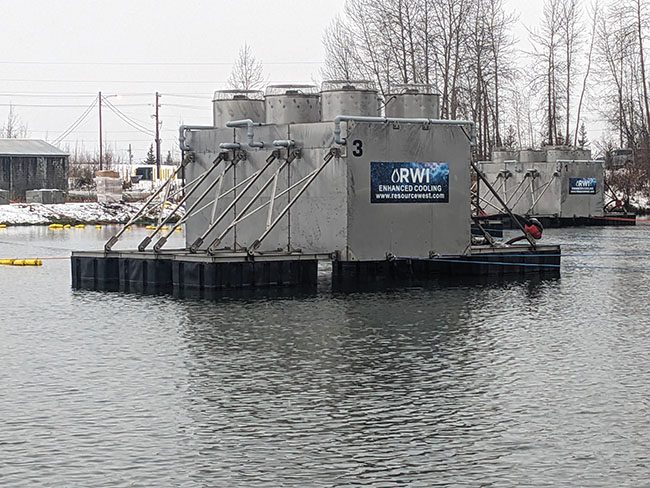 |
|
3. HydraCool units by RWI Enhanced Evaporation are placed on cooling ponds to provide auxiliary cooling. Courtesy: RWI Enhanced Evaporation |
“Multiple units on one pond create the smallest footprint and lowest cost per million Btus removed,” said Ballantyne.
The RWI HydroCool floating cooling tower upgrades heat rejection capacities to fix cooling layers, sprayer ponds, cooling ponds, and cooling return canals. There is no need for expensive foundation engineering, geotechnical evaluation, or foundation construction. It provides a way to increase generation capacity by adding additional heat rejection to the surface of pre-existing sprayer ponds, impoundments, cooling loops, and cooling canals. It is available in sizes from 11 million Btus per hour to 200 million Btus per hour size, Ballantyne noted.
Sizing Up a Cooling Pond to Expand Plant Capacity
Another issue experienced by power plants is that their desire to size up their generation assets is sometimes thwarted by the amount of available land for a cooling pond. Perhaps the plant was designed to provide a certain number of MW and a turbine upgrade could provide 10% more capacity. Unfortunately, land limitations might prevent its execution as the amount of hot water produced would exceed the cooling capacity of the pond.
Take the case of a power plant in Alaska. Demand for power in the region was so great that it needed to increase output urgently, but severe limitations appeared to block progress at every turn. The existing cooling loop couldn’t be made larger. The underlying geology made it difficult to put in a fixed cooling tower solution. In any case, land availability for a large cooling tower infrastructure just wasn’t there, nor could the existing cooling pond be enlarged.
“Three HydraCool units increased the heat removal strip rate of the pond by 100 million Btus an hour and provided a large temperature drop,” said Ballantyne. By adding auxiliary cooling to the existing pond, the plant was able to increase its power output and gain more revenue while meeting the water intake temperature specification.
—Drew Robb (drewrobb@sbcglobal.net) has been a full-time freelance writer for more than 25 years specializing in engineering and technology.


